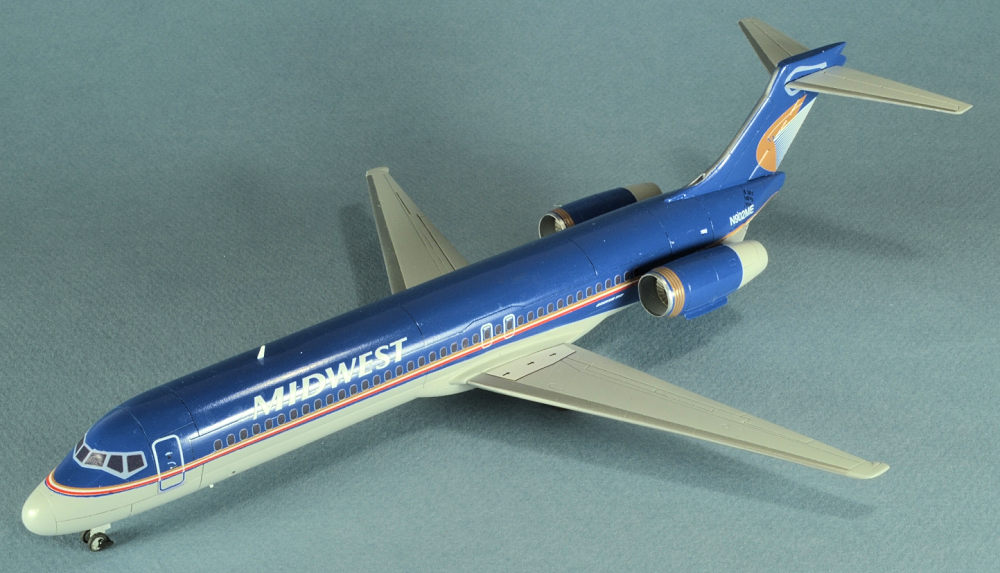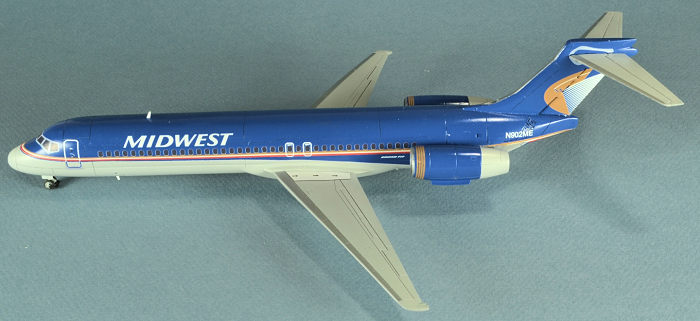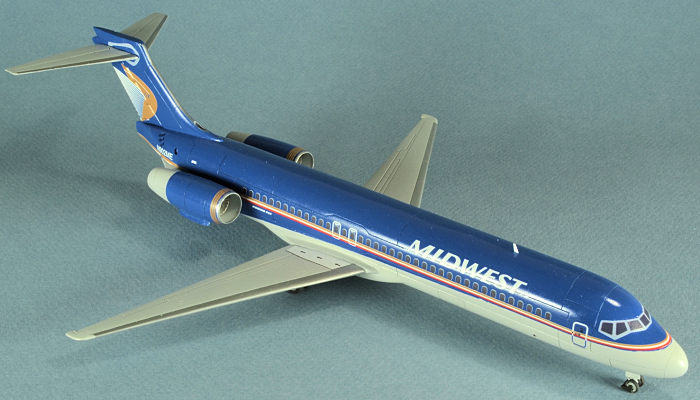
| KIT #: | ? |
| PRICE: | $60.00 |
| DECALS: | One option |
| REVIEWER: | Ben Brown |
| NOTES: | Draw Decals Midwest 717 |

| HISTORY |
 The
Boeing 717 is a continuation of the long-running Douglas DC-9 family. It was
originally marketed as the MD-87, but was renamed after McDonnell Douglass
merged with Boeing in 1997. Its light airframe and Rolls-Royce BR715 turbofans
helped make the 717 cheaper to operate than its competition of the time, the
737-500, and later, the 737-600 and -700. The jet was sort of the unwanted
stepchild in the Boeing jet family, and not many were built. The 717 can seat up
to 134 passengers and has a range of about 2000 miles. It entered service in
1999 with ValuJet Airlines (later renamed AirTran), and was produced until 2006,
with 156 717s being built. As of July 2016, 154 717s were still in service.
The
Boeing 717 is a continuation of the long-running Douglas DC-9 family. It was
originally marketed as the MD-87, but was renamed after McDonnell Douglass
merged with Boeing in 1997. Its light airframe and Rolls-Royce BR715 turbofans
helped make the 717 cheaper to operate than its competition of the time, the
737-500, and later, the 737-600 and -700. The jet was sort of the unwanted
stepchild in the Boeing jet family, and not many were built. The 717 can seat up
to 134 passengers and has a range of about 2000 miles. It entered service in
1999 with ValuJet Airlines (later renamed AirTran), and was produced until 2006,
with 156 717s being built. As of July 2016, 154 717s were still in service.
Midwest Airlines was a US-based airline that operated out of Milwaukee, Wisconsin from 1984 to 2009, when it merged with Frontier Airlines.
| THE KIT |
 Even
though this is a resin kit, it looks like a typical injection-molded kit. The
fuselage is split onto two hollow halves, with the wings, vertical and
horizontal stabilizers cast separately. Each engine nacelle is cast as one
piece, with finely-detailed inserts for the fan and exhaust. I think the kit’s
panel lines are a little deep, and the light gray paint seems to highlight them.
Even
though this is a resin kit, it looks like a typical injection-molded kit. The
fuselage is split onto two hollow halves, with the wings, vertical and
horizontal stabilizers cast separately. Each engine nacelle is cast as one
piece, with finely-detailed inserts for the fan and exhaust. I think the kit’s
panel lines are a little deep, and the light gray paint seems to highlight them.
This particular version included decals for the 717 demonstrator “Blue 1,” which had a complex pattern of white shapes covering a blue fuselage that faded to white as one went toward the nose. These decals looked like they might be ALPS-printed.
| CONSTRUCTION |
I had
to do a little cleaning up around the mating surfaces of the fuselage to get a
good fit. The tops of the fuselage had the remains of some casting blocks, which
took some sanding to remove. This opened up a dozen or so pinholes that I filled
with super glue and Mr. Surfacer. I wasn’t sure if the extra resin c ast
into the nose would offset the weight of the large engines, so I glued a couple
of fishing weights into the nose, just to be safe. The two halves fit together
without any trouble, and any gaps were filled with super glue and Mr Surfacer.
ast
into the nose would offset the weight of the large engines, so I glued a couple
of fishing weights into the nose, just to be safe. The two halves fit together
without any trouble, and any gaps were filled with super glue and Mr Surfacer.
The top of wing needed a little sanding to fix a rough patch, due to what looked like a flaw in the mold. I had to drill out the slots in the fuselage to accept the tabs from the wings. Once this was done, the wings fit well, and the gaps once again only needed some Mr Surfacer to fill.
The engine nacelles had large casting blocks to remove. This took some care, due to the thin resin around the exhausts. Strakes are cast into the outboard side of each nacelle and one was broken off and floating loose in the parts bag when the kit arrived. I quickly managed to lose it and had to make a new one with 0.005 styrene. The fan and exhaust details are cast separately and can be added after the model has been painted.
| COLORS & MARKINGS |
Midwest’s jets were painted in an attractive blue over Boeing Gray
scheme, with red and gold stripes separating the main colors. I first primed the
model with Tamiya gray primer, and then applied Mr Color 338 Light Gray, which
is supposed to be an exact match to a sample of Boeing Gray from the USAir paint
shop, according to a post on the Airlinercafe forum. The Mr Color paint is also
almost exactly the same color as
 Mr
Surfacer 1000. While the paint scheme appears simple, the demarcation between
the gray and blue starts out running parallel to the fuselage stripes, with a
thin strip of blue visible below the stripe, but breaks away and curves downward
as it goes further aft. I made a copy of the stripe decal, cut it out, and taped
it to the model, so I could make sure I was getting the break between the two
colors in the right place. I then painted the upper surfaces Humbrol French
Blue, which is a close match to Midwest’s blue. It’s been decades since I used
Humbrol paint, and I was pleased to find it airbrushes beautifully when thinned
with Mr Leveling Thinner. I painted the leading edges of the wings and tail
surfaces, and the engine intake lips with Alclad Aluminum. The
forward ¾ of the engine
pylons on the 717 are a darker metallic color, so I used Alclad Dark Aluminum,
and aft sections of the pylons are gray.
Mr
Surfacer 1000. While the paint scheme appears simple, the demarcation between
the gray and blue starts out running parallel to the fuselage stripes, with a
thin strip of blue visible below the stripe, but breaks away and curves downward
as it goes further aft. I made a copy of the stripe decal, cut it out, and taped
it to the model, so I could make sure I was getting the break between the two
colors in the right place. I then painted the upper surfaces Humbrol French
Blue, which is a close match to Midwest’s blue. It’s been decades since I used
Humbrol paint, and I was pleased to find it airbrushes beautifully when thinned
with Mr Leveling Thinner. I painted the leading edges of the wings and tail
surfaces, and the engine intake lips with Alclad Aluminum. The
forward ¾ of the engine
pylons on the 717 are a darker metallic color, so I used Alclad Dark Aluminum,
and aft sections of the pylons are gray.
The Draw Decals sheet provides all of the rest of the color for the
livery. These decals are printed with a “Next Generation Digital Silk” printing
process that requires a slightly different technique from silk-screened or
ALPS-printed decals. The ink on these decals do not respond to setting
solutions, so it must
 be heated
to conform to the curves on the model. I’ve had good results by placing the
decal on the model, and then using a paper towel dipped in near-boiling water to
firmly press it down. Sometimes this takes several applications, plus some
slicing with a knife to remove air bubbles, but eventually, the decals will lie
down and underlying surface detail will show through them. The only issue I
haven’t been able to completely solve is getting this type of decal to settle
into panel lines. The decals fit fine, except the aft sections of the fuselage
stripes needed a little tweaking around the trailing edges of the engine pylons.
be heated
to conform to the curves on the model. I’ve had good results by placing the
decal on the model, and then using a paper towel dipped in near-boiling water to
firmly press it down. Sometimes this takes several applications, plus some
slicing with a knife to remove air bubbles, but eventually, the decals will lie
down and underlying surface detail will show through them. The only issue I
haven’t been able to completely solve is getting this type of decal to settle
into panel lines. The decals fit fine, except the aft sections of the fuselage
stripes needed a little tweaking around the trailing edges of the engine pylons.
As with most airliner models, final assembly on this kit only involved adding the landing gear and some antennae. Even though the struts are resin, they seem to be up to the task of supporting the weight of the model. The kit doesn’t include the spray guards for the nose or main landing gear and some antennae, so I made them using some styrene sheet.
| CONCLUSIONS |
This is a very nice model of a somewhat rare airliner. The quality of the castings is excellent, and the fit is very good. As is usually the case when I finish an expensive resin or vacuform kit, Eastern Express released an injected 1/144 717 just a few days after I put this model in my display case. Sigh.
26 July 2018
Copyright ModeingMadness.com
If you would like your product reviewed fairly and fairly quickly, please contact the editor or see other details in the Note to Contributors.
Back to the Main Page Back to the Review Index Page Back to the Previews Index Page